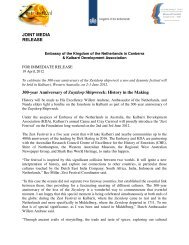Download our K-12 education pack - ARC Centre of Excellence for ...
Download our K-12 education pack - ARC Centre of Excellence for ...
Download our K-12 education pack - ARC Centre of Excellence for ...
Create successful ePaper yourself
Turn your PDF publications into a flip-book with our unique Google optimized e-Paper software.
stories <strong>for</strong> teachers & students 2013<br />
Ship <strong>of</strong> Fools Not the Dutch!<br />
Supporting Res<strong>our</strong>ces<br />
Dutch Lives in the World<br />
stories by winthrop pr<strong>of</strong>essor susan broomhall<br />
In the seventeenth century, the Dutch were well known as the<br />
best boat builders in the business. But this hadn’t always been<br />
the case. Just a century or two earlier, no one would have<br />
thought twice about them. But when they realised that expansion<br />
<strong>for</strong> their nation would have to happen via the sea, the Dutch paid<br />
attention to the best in the business (Germans) and learnt to do<br />
it even better.<br />
Not only were their building practices fast and efficient and not<br />
too costly, but the boats they built were well designed. They were<br />
fast and manoeuvrable, and needed fewer crew than other<br />
European vessels. They were shallow-bottomed which meant<br />
they could come in close to the coast and were very stable in the<br />
water. Even their rivals thought so. One Portuguese merchant<br />
wrote <strong>of</strong> the Dutch sailors that ‘they go with their ships all over<br />
the world and to places where <strong>our</strong>s cannot navigate’.<br />
It might be surprising but some <strong>of</strong> the international experts <strong>of</strong><br />
these Dutch building techniques are right here in WA. A whole<br />
raft <strong>of</strong> old shipbuilding skills had to be re-learned by shipwrights<br />
in Fremantle in order to build the replica Duyfken plank-first in<br />
the old way. This was launched in 1999.<br />
One <strong>of</strong> the things that hampered other nations from competing<br />
with the Dutch were monarchs who pushed their shipwrights to<br />
build ever more ambitious ships that showed <strong>of</strong>f their power and<br />
glory, without an eye to practical concerns. Many were heavily<br />
decorated and painted. Kings liked cannons which looked<br />
impressive to opponents but were heavy. Too many guns would<br />
sink the ship. Gustavus Adolphus found this out the hard way,<br />
when the Vasa, the pride <strong>of</strong> the Swedish fleet with its beautiful<br />
gold-leaf decoration, sunk in Stockholm harb<strong>our</strong> only <strong>12</strong>0 metres<br />
from shore on its maiden voyage in August 1628 in front <strong>of</strong> the<br />
most <strong>of</strong> the city’s population who had turned out to see it sail.<br />
He had given his (Dutch) shipwrights all manner <strong>of</strong> headaches,<br />
specifying the measurements they were to use <strong>for</strong> the ship and<br />
hurrying them to have it in the water as soon as possible.<br />
Early modern people enjoyed these morality tales, <strong>of</strong> those in<br />
high places who grew too proud <strong>of</strong> their own abilities and then<br />
crashed back down to earth, or in this case, sank to the bottom<br />
<strong>of</strong> the sea.<br />
IMAGE/ Reinier Zeeman, Quelque Nauires (Some Ships) 1652. © The Trustees <strong>of</strong> the British Museum<br />
FAR FROM HOME: ADVENTURES, TREKS, EXILES & MIGRATION<br />
63












